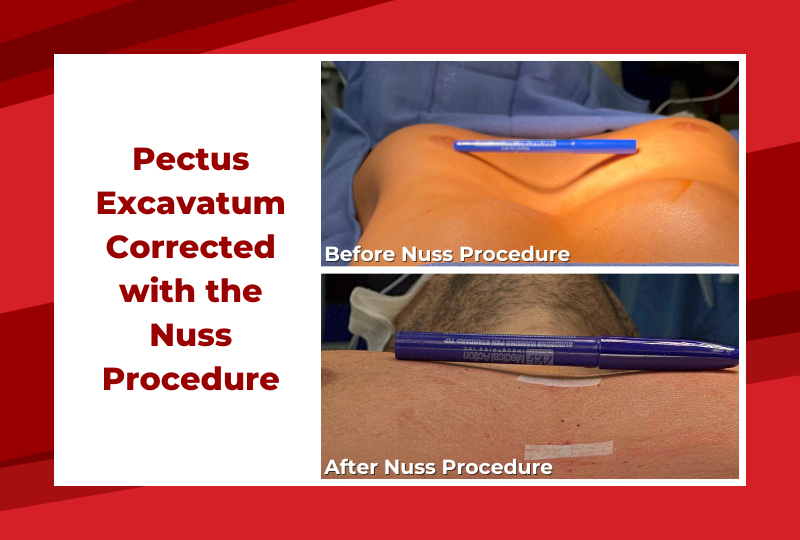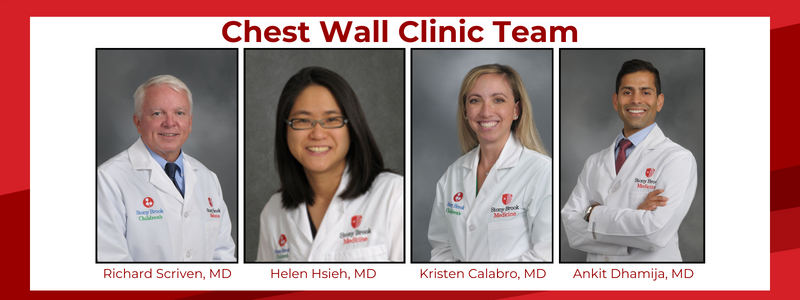Pectus Excavatum (PE), commonly known as sunken or funnel chest, is a congenital deformity that can cause kids, especially teens and young adults, to have body image issues, encounter challenges when exercising or playing sports and, in some cases, experience other health problems. Doctors from Stony Brook's Cardiothoracic and Pediatric Surgery divisions have created a Chest Wall Clinic for PE patients and their families to meet our surgeons, devise a treatment plan, schedule any required preoperative tests and create a system to follow up on these patients during their post-op recovery.
PE causes the sternum (breastbone) and a number of ribs to grow abnormally. The chest wall caves in creating a concave look. In mild cases, the appearance may cause the individual to be self-conscious about how they look. In severe cases, PE can cause problems with the lungs or heart. According to Dr. Richard Scriven, pediatric surgeon at Stony Brook, PE "usually becomes evident as [a child] goes through their adolescent growth spurt. Some kids have a very subtle defect and [feel like] they're at the end of their rope. [They feel self-conscious because they] can't take [their] shirt off at the beach."
Stony Brook's surgeons will be using the Nuss Procedure with cryoablation to treat PE patients. The Nuss Procedure, is a minimally invasive surgery to fix PE and is named for Dr. Donald Nuss a pediatric surgeon from Virginia who was seeking a new and innovative technique to address PE. This procedure is usually done on adolescents/young adults because their chest structure is still malleable enough to be fixed with the Nuss bar.

The Nuss Procedure, done under general anesthesia, is minimally invasive because it is done with a laparoscope and only requires small incisions on each side of the chest. Stony Brook's surgeons also use cryoablation as part of the procedure. Cryoablation basically freezes the nerves in the chest and helps to reduce post-op pain and make recovery a little bit easier. The surgeons next place a u-shaped titanium bar (the new titanium bar helps to avoid potential nickel allergies that were previously possible in older bars) through one of the incisions, rotate the bar so the u-shape is facing down and then attach it to the patient's chest wall with stitches. The bar is usually kept in for two to three years and is removed with a minor surgical procedure.
Prior to the Nuss Procedure's development, PE correction was approached with a much more invasive operation called the Ravitch Procedure (introduced by Dr. Mark Ravitch in 1949). This would entail cutting open the patient's chest and reconstructing it. The Ravitch Procedure, because of its invasive nature, required a long hospital stay, long recovery period and the patient often experienced more post-op pain, which required stronger medications. Patients would need to schedule their surgery during long school holiday breaks because of the extended recovery time.
"We are excited to offer a multi-disciplinary chest wall clinic to treat a variety of complex chest wall disorders," said Dr. Ankit Dhamija
Nuss Procedure patients will usually stay overnight in the hospital (longer stays are uncommon). Opioid use is reduced because of the minimally invasive aspect and cryoablation part of this procedure. The patients may be sore for the first few weeks and full recovery from the surgery may take up to six months, but most are back to regular activities much sooner. Heavy lifting and contact sports should be avoided during the healing period.
Stony Brook Medicine's surgeons are currently the only ones offering the Nuss Procedure with cryoablation in Suffolk County. The Chest Wall Clinic will be held on Friday's at Stony Brook Medicine's Surgical Care Center at 37 Research Way in East Setauket, New York. Potential patients should call:
- 631-444-2293 for patient <18
- 631-444-2981 for patents >18

"We are excited to offer a multi-disciplinary chest wall clinic to treat a variety of complex chest wall disorders," said Dr. Ankit Dhamija (Cardiothoracic Surgery). "Specifically to Pectus Excavatum patients, the Nuss procedure has [an] overall satisfaction [rating] of 95.6 percent of patients being either satisfied or very satisfied after the operation. The addition of Cryoablation to this procedure and many other cases has made the initial recovery much more tolerable and patients are being discharged one-to-two days after the operation."
Future plans for the Chest Wall Clinic include expanding it to other chest wall disorders, such as rib fractures, sternal fractures or chest wall masses that may require larger reconstruction. Stony Brook's doctors participating in the Chest Wall Clinic include Doctors Dhamija, Scriven, Helen Hsieh (Pediatric Surgery) and Kristen Calabro (Pediatric Surgery).

